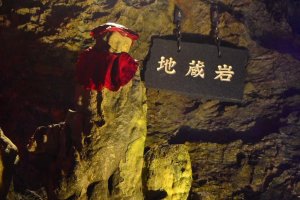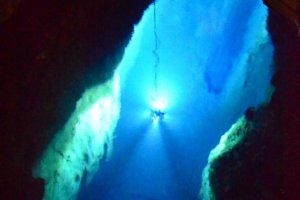Deep in the eastern base of the jagged Mount Ureira, there lives a very long ‘dragon’. This ‘dragon’, or 'ryu' in Japanese, is actually an extensive limestone cave, referred to as “cave of the dragon spring” or Ryusendo Cave. It is recognized as one of three great limestone caves in Japan after Akiyoshida in Yamaguchi Prefecture, and Ryugado in Kochi Prefecture. Ryusendo cave is located a short distance by car or bus from the main street of Iwaizumi Town, Iwate Prefecture.
Ryusendo Cave, also known as Iwaizumi Wakkutsu, is made up of a single main cavern, complete with other multiple branch caverns that cross and intersect it. When you stand in front of the cave entrance, you will hear the strong sound of rushing water inside. The average flow rate of spring water inside is 1.5 tons per second.
Ryusendo Cave is well-known as having the deepest subterranean lakes of any cave in Japan. It has three main lakes of varying depths. The first one, a primary subterranean lake of 35 meters in depth, was discovered in the 1920s. Exploration of the cave was only possible using boats at that time. The next in line, a secondary subterranean lake, is slightly deeper than the first. 38 meters in depth, it was discovered in 1962, 40 years after the discovery of the primary lake. The deepest section is occupied by a tertiary lake that is 98 meters deep! This is the most amazing lake inside Ryusendo Cave. The water has a very clear, vivid blue color and the bottom is almost visible! It was discovered five years after the second subterranean lake. The tertiary subterranean lake marks the last point up to which visitors can explore this part of the cave.
All of the lakes are filled with very clean water of high mineral content. Visitors will be amazed with the stunning view of the lakes. They are illuminated with lamps that hang inside of the water making the bottom visible to the naked eye. This is surely an awesome sight!
Ryusendo Cave is situated parallel to another cave, located just across the street, and the same water system flows through both caves. The caves are actually connected to each other but are divided by the Shizu River.
As with other cave systems, there are many species of bats that inhabit Ryusendo Cave. Of the five species present, all of them are nocturnal and eat insects. They are quite small in size. In one part of Ryusendo Cave, there is a species of bat that cannot be captured without special permission.
Another interesting feature of the cave aside from the very deep subterranean lakes, are the copious stalagmites and stalactites that have unique shapes. A famous example is a stalagmite in the shape of Jizo, the guardian deity of travelers and children. Typically, stalactites and stalagmites grow very slowly. On average, only about one centimeter every 50 years for stalactites and one centimeter every 100 years for stalagmites. Their formation is mostly affected by atmospheric temperature and water quantities.
Researchers and geologists have explored up to 3100 meters of the cave length. It was predicted that the actual length of Ryusendo could extend to as much as 5000 meters. Surveys and research are still in progress to this day.
For an unforgettable day out to one Tohoku's greatest natural wonders, look no further than Ryusendo cave!

































